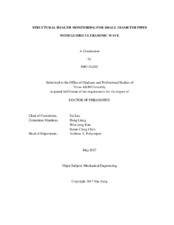| dc.description.abstract | The structural health monitoring (SHM) paradigm includes device design for data acquisition and signal processing for defect visualization. An excitation is applied to the interested structure to generate vibration which is measured and analyzed to reveal structural defects. Guided ultrasonic wave (GUW) has proved to be effective as an excitation for shell SHM. Device settings and corresponding signal processing methods have been proposed to detect defects over plate and plate-like structures. However, there is no effective SHM paradigm for small diameter pipes having salient curvatures. By utilizing GUW, we proposed three methods for SHM over pipes for different application backgrounds.
The first method detects the defect axial position. Measurements are acquired by our innovative dual transducer array design and are processed with the Multiple Signal Classification (MUSIC) signal processing method. The defect position is predicated accurately and efficiently, which is very adaptive for SHM over long pipes. However, it fails to predicate the defect circumferential position.
The second method detects both defect axial and circumferential positions. Measurements are acquired via the same transducer array setting as the previous method, and are processed by a novel method, Geodesic Distance MUSIC (GD-MUSIC) method, based on the assumption that the defect-reflected GUW only travels along the geodesic path embedded in pipe surfaces. It predicates the defect axial and circumferential positions accurately for single-defect cases. However, the detection accuracy is affected if it is applied to multiple-defect cases because the geodesic assumption does not hold, which inspires us to design the third method.
The third method detects multiple defects as well as a single defect over pipes. After being acquired by the dual array setting, measurements are processed by an innovative statistical Predominant Component Voting MUSIC (PCV-MUSIC) method, which identifies defect locations on aggregation of a trove of inaccurate detection results. A pipe is unwrapped regarding different axial cuts to form different voters. Votes casted by voters are pipe images of voters obtained from MUSIC method. The polling result predicates both axial and circumferential defect positions even for multiple defects.
Finally, all methods are validated by multiple simulation cases. | en |


